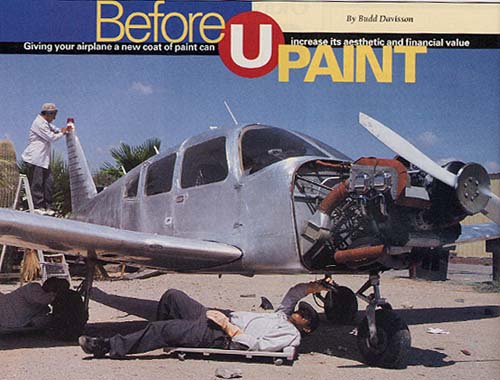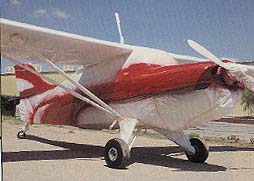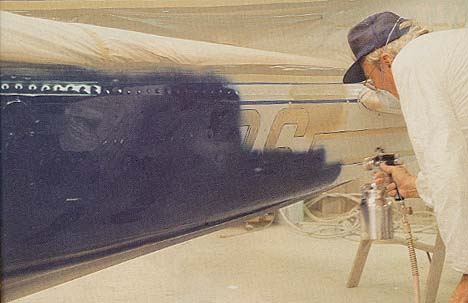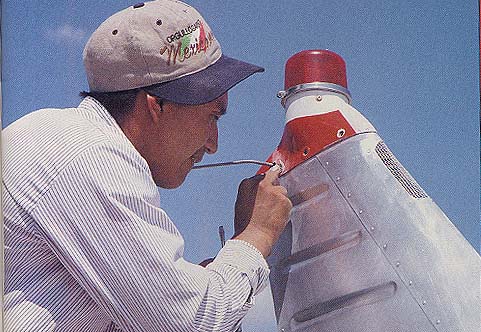
Article: Painting

'Want to instantly increase the value and salability of your airplane? Put a nicely done paint job on it. Want to instantly decrease the value and salability of your airplane? Put a badly done paint job on it.
Painting an airplane has a lot of the aspects of selecting a computer, picking a wife or naming your first born. There are so many absolutely hard criteria you have to apply to the situation but then everything is overlaid with a thick cushion of subjectivity further complicated by the demons of finances. In other words, simply deciding to paint your airplane isn't simple.
Let's ignore the subjectivity of colors, schemes and so forth and first talk about the process itself and how you, the airplane owner, can fit yourself into it. Or not fit yourself into it, it's up to you.
First, it should be understood that there are paint jobs and there are paint jobs. A good one is worth it's weight in gold in terms of the protection it affords and the quality image it exudes. The flip side to that, is that if you do, or have done, a questionable paint job, its problems can't be hidden. Of all the things on an airplane that stick out like a sore thumb, the paint job is it. You may have the finest bird in the world, but if it has a poorly done paint job, that's the image of quality it is going to project. The Mona Lisa wasn't painted with a roller and your airplane shouldn't be either.
It would be nice if finances weren't an issue, but, unfortunately, they usually are. A first class paint job on a Cherokee 140 done at a quality shop may run as high as $7000 with $3500 being average. That's spending nearly a fourth the worth of the airplane on paint. Will the airplane increase that much in value? Probably not. It costs only a little more to do a similar job on a Bonanza. Will it return the cost in increased value? Almost certainly.
If you read between the lines on paint jobs you realize there are levels of difficulty and "completeness." A paint job that is done absolutely right, that is ten on a scale of one to ten, includes;
· stripping the airplane down to bare metal and getting it perfectly clean.
· Disassembling major components, removing ailerons and flaps as well as all panels so the interior edges of those components can be evenly painted. A good clue on how an airplane was painted is to look inside the aileron wells. Is the paint even or was it blown in through the gap? Or look at panel screws and hinge bolts. Were they painted in place or separately?
· Painting all the minor pieces separately, including all the screws, is a pain but necessary for a factory look.
 All
of the above processes take labor, labor and more labor. Stripping,
for instance, is a long, nasty detailed process that to yield
a good paint job must be carried out down to the tiniest crevice
and rivet edge. It also carries with it an element of risk to
the more fragile parts of the airplane like windshields, seals,
etc.
All
of the above processes take labor, labor and more labor. Stripping,
for instance, is a long, nasty detailed process that to yield
a good paint job must be carried out down to the tiniest crevice
and rivet edge. It also carries with it an element of risk to
the more fragile parts of the airplane like windshields, seals,
etc.
Disassembly and reassembly requires even more time and must be done by licensed, experienced people and also includes the risk of damaging the components while they are apart.
Assuming you do none of the work yourself, the only way to reduce the cost of a paint job (all other things being equal) is to back down from the ten point paint job, skip a few of the labor intensive processes and use less expensive paint. Here are a few places money can be saved.
· Don't strip, sand; An airplane doesn't have to be stripped to get a good paint job. Yes, stripping is the right thing to do and it saves weight, but stripping isn't necessary. It is both possible and practical to sand the existing paint, assuming it is adhering and isn't overlaying corrosion, and paint over it. The sanding process itself, is labor-intensive and must be done carefully, getting down into all the tiny areas because most modern paints depend on surface roughness for adhesion because they don't melt themselves into the prior layers. At the same time, the sanding must be smooth or else the scratches will show through. A properly done sand-and-paint job is almost indistinguishable from a strip-and-paint job but it weighs twice as much which is an important factor on re-balancing control surfaces as well as raising empty weight of the aircraft. Paint jobs commonly add something in the neighborhood of 40-50 pounds or more to an airplane.
· Don't disassemble the airplane. Just leave everything in place and paint away. This is the equivalent of the old "closed door paint job" done on cheap car re-paints. If going this route, don't change the color of the airplane as the old color will still exist under every panel and in hard to get at areas. Painting an airplane that hasn't been disassembled will produce a lot of painted-over bolt heads which is a sure sign that corners have been cut.
· Use cheaper paint. Some of the high end urethane paints are touching $400 a gallon with $200 being very common. Urethane produces a strong, durable finish, but for years airplanes were painted with several variations of enamels. Even automotive urethanes can be expensive, but modern enamels are quite reasonably priced and will still last until you're tired of looking at the paint job.
Here is one thing you DON'T do to lower the cost of your paint job: don't go to a guy who isn't good with a spray gun. Find samples of his or her work and inspect them for orange peel, runs/sags, dirt, etc. The final coats are what make the finish and don't ever underestimate the value of the talent behind the spray gun. The right kind of talent is a rare commodity and nowhere nearly as common as it once was. Spend your money on the guy with the gun and save it elsewhere in the process.

If you're mechanically inclined, ou can also save money if the paint shop will let you pitch in and help with the disassembly.
Can you actually paint your airplane yourself? Sure, lots of people do, but the result is almost never as good as that produced by a high quality shop with the proper equipment and, more important, the proper experience. Not many folks are going to paint more than one or two airplanes in their life times, so the experience doesn't build up very quickly.
Another consideration for the do-it-yourselfer is that urethane paints are some of the most dangerous substances on Earth when it comes to what they can do to your respiratory system. A regular paint mast won't protect you. A full face mask with fresh air pumped in from someplace else is a must. Shooting urethane type paints just isn't something to be approached casually. Many hobbyists do it, but they approach it the same way the pros do. If they don't, the paint job will last longer than they do.
If shooting the paint yourself, it would be worth it to look into some of the alkyd enamels and other, less dangerous and more easily applied automotive paints.

Here's one final consideration...the paint scheme and colors. The paint is the very first thing you see on an airplane. Long before you're close enough to it to see the bumps and warts in the airframe, the paint scheme has told you whether it appeals to you or not. Now, think about resale. Few of us keep the same airplane for a life time, so at some time that paint scheme is going to have to appeal to someone else to make them want to buy it.
There is a tendency when repainting airplanes to think in terms of personalization, rather than resale. This is perfectly okay and laudable, if the airplane is going to stay with you a long time. At the same time, think how many airplanes you've seen where your first thought was "Yeeech! What was that guy thinking?" Beauty is in the eye-of and all that kind of thing. You can never go wrong with a factory paint scheme or something that mimics that style; boring white with predicable stripes and bars. You'd be surprised how many folks don't really want a bright orange Bonanza with purple checkerboard wings. If, however, that's your thing, go for it but do it as well as possible.
When painting an airplane, just remember, once it's finished, if you cut a corner and did something that sticks in your craw every time you see it, maybe it would have been better to spend more money and do it right in the first place. You're going to be looking at that paint for a long time, so make it something you're proud of. BD